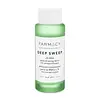What's inside
What's inside
 Key Ingredients
Key Ingredients

 Benefits
Benefits

 Concerns
Concerns

 Ingredients Side-by-side
Ingredients Side-by-side

Water
Skin ConditioningButylene Glycol
HumectantDipropylene Glycol
Humectant1,2-Hexanediol
Skin ConditioningGlycerin
HumectantNiacinamide
SmoothingEthylhexylglycerin
Skin ConditioningCaprylyl Glycol
EmollientBetaine
HumectantCellulose Gum
Emulsion StabilisingVinegar
Citric Acid
BufferingAdenosine
Skin ConditioningDisodium EDTA
Salix Alba Bark Extract
AstringentDaucus Carota Sativa Leaf Extract
Skin ConditioningOriganum Vulgare Leaf Extract
Skin ConditioningBacillus/Soybean Ferment Extract
Skin ConditioningBeer Extract
Skin ConditioningBetula Alba Bark Extract
MaskingGold
Cosmetic ColorantBetaine Salicylate
AntimicrobialGlycolic Acid
BufferingLaminaria Digitata Extract
Skin ProtectingMacrocystis Pyrifera Extract
Skin ConditioningGelidium Cartilagineum Extract
Skin ProtectingPalmaria Palmata Extract
Skin ProtectingSpirulina Amino Acids
Skin ConditioningTromethamine
BufferingGluconolactone
Skin ConditioningCapryloyl Salicylic Acid
ExfoliatingCaprylic/Capric Triglyceride
MaskingHydroxydecyl Ubiquinone
AntioxidantPolyglyceryl-10 Oleate
Skin ConditioningHydrogenated Lecithin
EmulsifyingWater, Butylene Glycol, Dipropylene Glycol, 1,2-Hexanediol, Glycerin, Niacinamide, Ethylhexylglycerin, Caprylyl Glycol, Betaine, Cellulose Gum, Vinegar, Citric Acid, Adenosine, Disodium EDTA, Salix Alba Bark Extract, Daucus Carota Sativa Leaf Extract, Origanum Vulgare Leaf Extract, Bacillus/Soybean Ferment Extract, Beer Extract, Betula Alba Bark Extract, Gold, Betaine Salicylate, Glycolic Acid, Laminaria Digitata Extract, Macrocystis Pyrifera Extract, Gelidium Cartilagineum Extract, Palmaria Palmata Extract, Spirulina Amino Acids, Tromethamine, Gluconolactone, Capryloyl Salicylic Acid, Caprylic/Capric Triglyceride, Hydroxydecyl Ubiquinone, Polyglyceryl-10 Oleate, Hydrogenated Lecithin
Water
Skin ConditioningArginine
MaskingSalicylic Acid
MaskingLactobacillus/Papaya Fruit Ferment Extract
AbrasiveMoringa Oleifera Leaf Water
Skin ConditioningMoringa Oleifera Seed Extract
Skin ConditioningEucalyptus Globulus Leaf Water
MaskingChlorella Ferment
Skin ConditioningPaeonia Suffruticosa Root Extract
Skin ProtectingScutellaria Baicalensis Root Extract
AstringentLactic Acid
BufferingGlycerin
HumectantButylene Glycol
HumectantXylitylglucoside
HumectantAnhydroxylitol
HumectantXylitol
HumectantLeuconostoc/Radish Root Ferment Filtrate
AntimicrobialGluconolactone
Skin ConditioningMaltodextrin
AbsorbentGlucose
HumectantPotassium Sorbate
PreservativeSodium Benzoate
MaskingWater, Arginine, Salicylic Acid, Lactobacillus/Papaya Fruit Ferment Extract, Moringa Oleifera Leaf Water, Moringa Oleifera Seed Extract, Eucalyptus Globulus Leaf Water, Chlorella Ferment, Paeonia Suffruticosa Root Extract, Scutellaria Baicalensis Root Extract, Lactic Acid, Glycerin, Butylene Glycol, Xylitylglucoside, Anhydroxylitol, Xylitol, Leuconostoc/Radish Root Ferment Filtrate, Gluconolactone, Maltodextrin, Glucose, Potassium Sorbate, Sodium Benzoate
 Reviews
Reviews

Ingredients Explained
These ingredients are found in both products.
Ingredients higher up in an ingredient list are typically present in a larger amount.
Butylene Glycol (or BG) is used within cosmetic products for a few different reasons:
Overall, Butylene Glycol is a safe and well-rounded ingredient that works well with other ingredients.
Though this ingredient works well with most skin types, some people with sensitive skin may experience a reaction such as allergic rashes, closed comedones, or itchiness.
Learn more about Butylene GlycolGluconolactone is a PHA. PHAs are a great gentle alternative to traditional AHAs.
When applied, Gluconolactone has the same affect on skin as AHAs such as lactic acid. It helps dissolve the dead skin cells in the top layer of your skin. This improves texture and brightens the skin.
PHAs are more gentle than AHAs due to their larger structure. They do not penetrate as deeply as AHAs and take a longer time to dissolve dead cells. Studies show PHAs do not cause as much irritation.
Gluconolactone has some interesting properties:
In a 2004 study, Gluconolactone was found to prevent UV damage in mouse skin cells and has not been found to increase sun sensitivity. However, we still recommend wearing SPF daily.
This ingredient is is an created by reacting gluconic acid with an alcohol.
Learn more about GluconolactoneGlycerin is already naturally found in your skin. It helps moisturize and protect your skin.
A study from 2016 found glycerin to be more effective as a humectant than AHAs and hyaluronic acid.
As a humectant, it helps the skin stay hydrated by pulling moisture to your skin. The low molecular weight of glycerin allows it to pull moisture into the deeper layers of your skin.
Hydrated skin improves your skin barrier; Your skin barrier helps protect against irritants and bacteria.
Glycerin has also been found to have antimicrobial and antiviral properties. Due to these properties, glycerin is often used in wound and burn treatments.
In cosmetics, glycerin is usually derived from plants such as soybean or palm. However, it can also be sourced from animals, such as tallow or animal fat.
This ingredient is organic, colorless, odorless, and non-toxic.
Glycerin is the name for this ingredient in American English. British English uses Glycerol/Glycerine.
Learn more about GlycerinWater. It's the most common cosmetic ingredient of all. You'll usually see it at the top of ingredient lists, meaning that it makes up the largest part of the product.
So why is it so popular? Water most often acts as a solvent - this means that it helps dissolve other ingredients into the formulation.
You'll also recognize water as that liquid we all need to stay alive. If you see this, drink a glass of water. Stay hydrated!
Learn more about Water